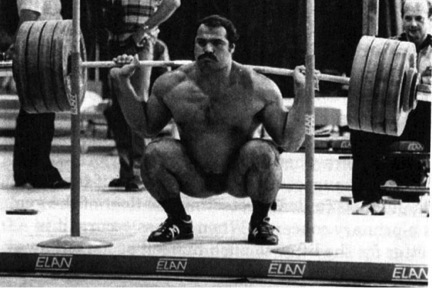Written by Greg Robins
Last installment we took a look at the Back To Wall Shoulder Flexion drill. We talked about how to perform the test, why it’s important, and a few ways to correct any deficiencies.
Today I want to talk about the ankle, and in particular how to assess adequate dorsiflexion.
The main theme in today’s post is the ability to dorsiflex the ankle so that the knee may pass the toes freely whilst keeping the foot in the proper position against the ground.
To illustrate the importance of this concept I perused the JTS website and found some pictures, let’s have a look:
Here is a picture of Anthony Pomponio a JTS athlete. Sure, he doesn’t seem to be fully geared up to begin this lift, but you can see very clearly the amount of ankle mobility needed for him to achieve this starting position. The knees have surpassed the toes, while the foot remains in full contact with the ground (not taking footwear into account, for now).
In case you need more evidence as to the importance of ankle mobility:
and one more for good measure:
As you can see, it’s pretty much a must for any deep squat position. As well as basic lunge positions, running, and jumping as well.
Assessing ankle mobility on yourself is pretty straightforward, but the devil is in the details, let me explain without trying to shift the focus away from the ankle itself too heavily.
Take a look at this easy to do self-assessment:
Wall Ankle Mobility DrillYou may have seen something similar in the Functional Movement Screen, or if you have watched Cressey, Robertson, and Hartman’s “Assess & Correct” DVD. It’s tough to standardize any test, but in talking to Eric Cressey, and physical therapist Mike Reinold, 3-5” from the wall is a good number to shoot for adequate mobility.
It is also important as I stated in the video that you track correctly, and are able to maintain all three points of contact with the foot. The foot is a joint in itself and if you allow it to flatten too heavily you are gaining mobility from an area other than the ankle.
So what if you can’t pass the test? Should you stop squatting, jumping, sprinting, etc?
Yes and no.
Most likely those folks who cannot pass this test are already having a hell of a time trying to reach a good deep squat position. In fact, the top three things I look to improve / assess (from a movement restriction standpoint) in order to iron out someone’s squat are the ankles, anterior core, and thoracic spine.
If you fail this test and suffer from ankle pain, knee pain, or just can’t seem to hone in technique with a deep squat no matter what you try, then maybe yes, you should back off a traditional squat until you can pass the knee well enough over the toes.
If you seem to be just fine, but still can’t pass the test, then I would simply make it a point to do more of what I’m about to show you.
Before we get started, it is of final note that those who pass the test as well can use these drills. They are good exercises in exploring movement, and preparing the joint for more intense load bearing exercises in end ranges.
The initial step:
Self myofascial release is the first place to start. Simply do more self-massage to your calves.
I prefer to use a baseball or golf ball along the back and sides of the calf. I will kneel on top of a foam roller to get the front side of the lower leg.
Moving forward:
From there I would explore some ranges of motion.
If you have very little dorsiflexion here is a great place to start:
Knee Break Ankle Mobs:
Additionally, I think the test itself lends itself well to those severely lacking in range of motion.
More intermediate drills include:
Tri-Planar Wall Ankle Mobs:
Ankle Mobs w/ Band Traction:
For the more advanced, and as a good drill for those who already have the dorsi-flexion:
TRX Deep Squat Prying:
The third step:
Once we have explored some ranges of motion, one thing I have begun adding in with great success is some more active mobility drills that I learned from Dr. Andreo Spina’s Functional Range Conditioning Course.
Check out these videos:
Dorsiflexion lifts:Plate assisted dorsiflexion lifts:
To wrap it up:
Ankle mobility is crucial to proper positioning in a variety of lifts, as well as in athletics, and daily life. Today we see many athletes in high top footwear, taping, bracing, and weightlifting shoes. What I don’t see are heck of a lot of great scores on this simple assessment.
Do yourself a favor and try this one out and start littering in some of the drills you watched above.
Greg Robins is a Strength and Conditioning Specialist at Cressey Performance in Hudson, MA. Greg has worked with clientele ranging from general population to professional athletes. His unique experience in many different aspects of fitness, strength training, and athletic preparation have helped him become an unbiased authority on all things fitness and performance related. Outside of coaching Greg is a former collegiate baseball player, active member of the MA ARMY National Guard, and enjoys power lifting.
Website, Facebook, YouTube, Twitter












